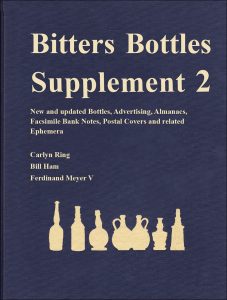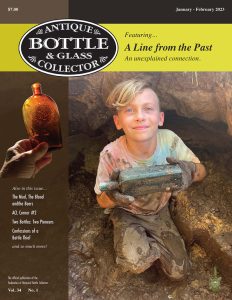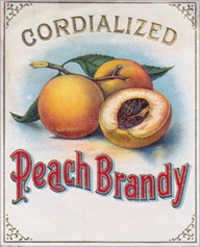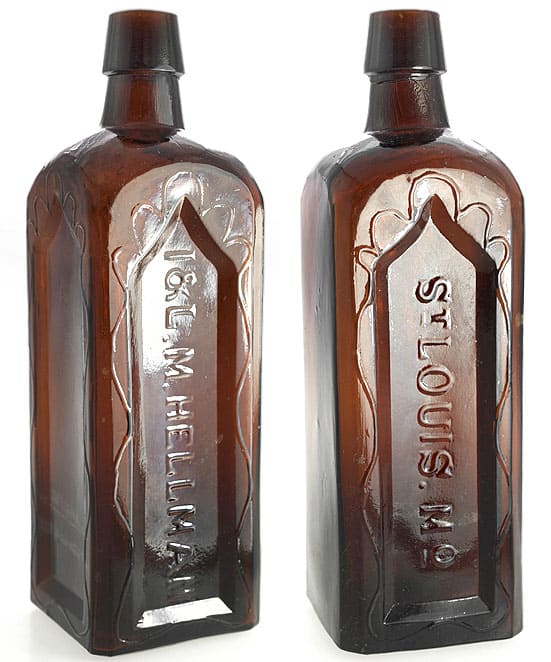
Who is I. & L. M. Hellman of St. Louis, Missouri?
09 April 2013 (R•011319) (R•110719)
 I received the following email and pictures from Matthew Levanti about a bottle embossed I & L. M. Hellman, St. Louis, Mo. This really looks like a bitters bottle that I bet I can shed some light on. The image at the top of the post is from a past Glass Works Auction.
I received the following email and pictures from Matthew Levanti about a bottle embossed I & L. M. Hellman, St. Louis, Mo. This really looks like a bitters bottle that I bet I can shed some light on. The image at the top of the post is from a past Glass Works Auction.
Hi Ferd, I was wondering if you have seen this square before? I am not seeing any others online although I do seem to remember seeing one before. This showed up for ‘show and tell’ at our first meeting of the newly resurrected Hangtown Bottle Necks bottle club last night (we had a total of 6 collectors show up, hopefully the number will grow!). It’s quite a beautiful bottle, such a shame its not embossed (with the word) bitters, although my hunch is it contained alcohol and that the company bottled different spirits and that’s why the bottle is not marked with a certain content.
It is embossed I & L. M. HELLMAN – ST. LOUIS. MO
A listing in the St Louis city directory for them in 1868 –
Hellman I. & L.M. (Louis M. Hellman), importers of wines, brandies and gins, and rectifiers for whisky. 112 Pine st
I also found a reference to L. M. Hellman swearing and allegiance to the U.S. Government and the state of Missouri in 1865, so he must of been a Confederate solider.
Thanks,
Matt
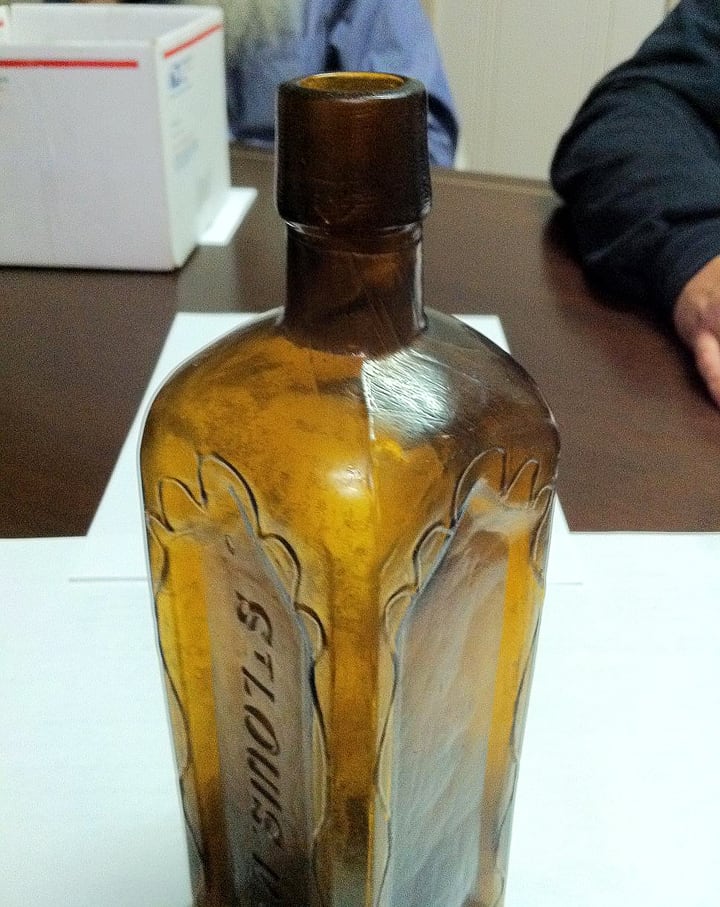
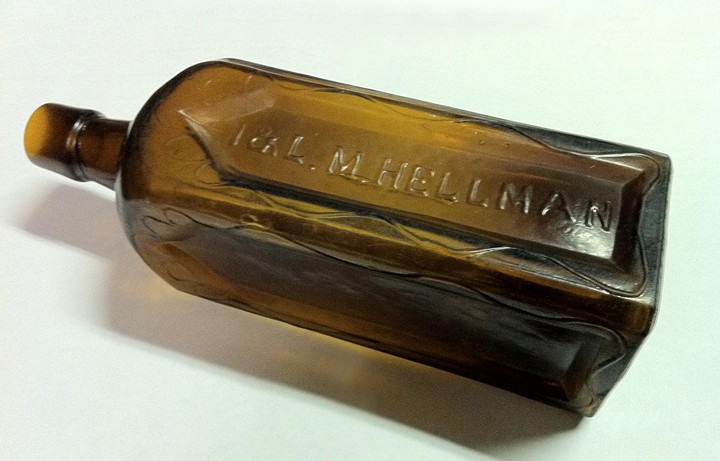
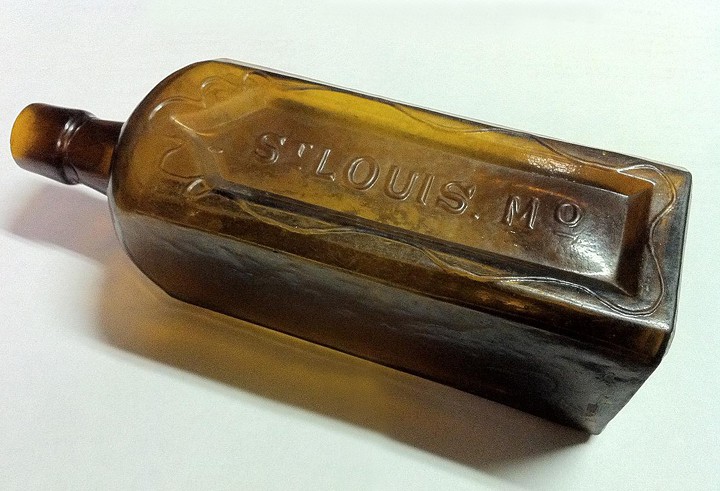
Matt, what a gorgeous square! I love the shoulder form and pattern. This sure rings a bell with me too. Though I have not seen this square before, I am familiar with the Hellman name. Various Hellman’s are listed in early St. Louis directories including Hellman & Myers (1863) and I & L Hellman (1864-1881) who marketed rye, bourbon and other spirits. They also had embossed bitters.
Below: Advertising cover from the Ben Swanson collection.
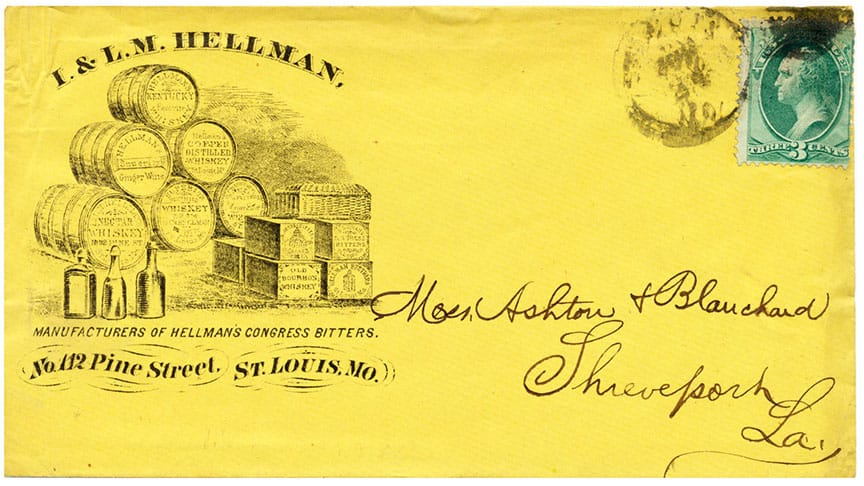
HELLMAN’S CONGRESS BITTERS
 Examples found during the excavation of the riverboat Twilight which sank near Orrick, Missouri in 1865.
Examples found during the excavation of the riverboat Twilight which sank near Orrick, Missouri in 1865.
The Carlyn Ring and Bill Ham listing in Bitters Bottles Supplement is as follows:
H 79 HELLMAN’S CONGRESS BITTERS
HELLMAN’S // CONGRESS BITTERS // ST LOUIS. MO // f //
8 3/4 x 2 5/8 (6 7/8) 5/16
Square, Amber, LTC, Applied mouth, 3 sp, Rare
There are two dots under the T of ST and the O of MO.
I. & L.M. Hellman
Similar bottle to I & L. M. HELLMAN, ST. LOUIS MO. (subject bottle above)
Daily Missouri Democrat: July 11, 1865
Example was dug in Denver, Colorado. Examples found during the excavation of the riverboat Twilight which sank near Orrick, Missouri in 1865.
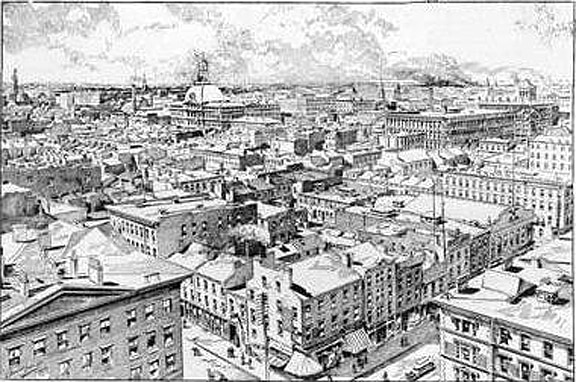
Illustration St. Louis – 1860
Isaac and Lewis M. Hellman – St. Louis
As early as 1862, the firm of I. & L. M. Hellman, composed of brothers Isaac Hellman and Louis M. Hellman, were engaged in the wholesale liquor business on Pine Street, in the city of St. Louis, Missouri. Their trade was confined principally to states down the Mississippi river and southwest. Both brothers were born in Germany in the early 1830s and made their way to America with the attraction of land, opportunity and religious freedom, and pushed out of Germany by economic conditions and religious or political oppression.
Their whiskey barrels employed in their trade, had a bird with wings spread, in imitation of a crow, burnt into the head of the barrel, and the word “Crow,” or the words “Old Crow,” were burnt beneath the image.
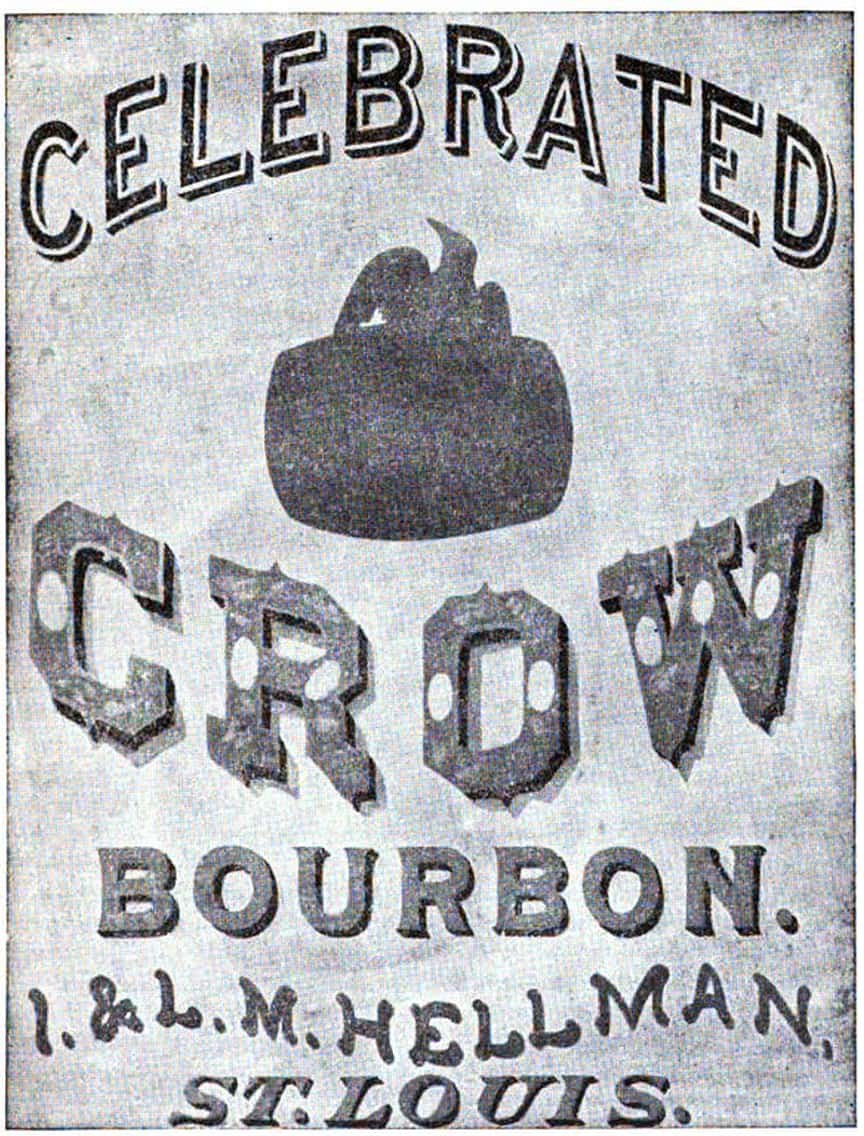
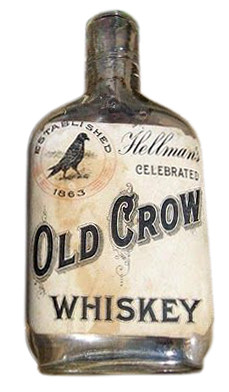 Hellman is a name associated with liquor dealing St. Louis for many decades. We first see listings for Hellman & Myers. The name changes to I. & L. M. Hellman from 1863 to 1881. This would be Isaac Hellman and Louis M. Hellman. From 1882 to 1900, it is A. M. Hellman & Co. (Moritz and Abraham Moses) and finally the Hellman Distilling Company (Charles Hellman) up to 1918. They were orginially located at 6 Pine Street from 1863-1866, then at 112 Pine from 1867-1887, and finally they were located at 508 N 2nd. The company used the brand names Arlington Club Bourbon, Arlington Club Rye, Arnold’s Bourbon, Arnold’s Rye, Elk Spring Bourbon, Elk Spring Rye, Gold Seal Rye, Hellman’s Congress Bitters, Hellman’s Cedar Grove Bourbon, Home Place B’b’n, Home Place Rye, O. V. F. Bourbon, Porter Bourbon, and Silver Spring Rye.
Hellman is a name associated with liquor dealing St. Louis for many decades. We first see listings for Hellman & Myers. The name changes to I. & L. M. Hellman from 1863 to 1881. This would be Isaac Hellman and Louis M. Hellman. From 1882 to 1900, it is A. M. Hellman & Co. (Moritz and Abraham Moses) and finally the Hellman Distilling Company (Charles Hellman) up to 1918. They were orginially located at 6 Pine Street from 1863-1866, then at 112 Pine from 1867-1887, and finally they were located at 508 N 2nd. The company used the brand names Arlington Club Bourbon, Arlington Club Rye, Arnold’s Bourbon, Arnold’s Rye, Elk Spring Bourbon, Elk Spring Rye, Gold Seal Rye, Hellman’s Congress Bitters, Hellman’s Cedar Grove Bourbon, Home Place B’b’n, Home Place Rye, O. V. F. Bourbon, Porter Bourbon, and Silver Spring Rye.
The Hellman clan was sued for trademark infringement by W.A. Gaines and Company, a Kentucky liquor company which had produced a very famous brand of “Old Crow” whiskey since 1835. Their Old Crow Whiskey was named for Dr. James C. Crow, a Scottish medical doctor who moved to Kentucky and in the 1830s used his knowledge of chemistry to invent the sour mash process for creating bourbon. The aged runs became known as “Old Crow” and were massively popular. After Dr. Crow’s death in 1856, W.A. Gaines and Co. continued to sell his original stock for as long as they could. When they ran out, they made a replica, although Crow’s exact formula was lost.
Read More: The Hellmans of St. Louis and the Battle Over “Old Crow”
“Old Crow” was the favorite brand of many notable 19th and 20th century figures like President Andrew Jackson, Kentucky Senator Henry Clay, Confederate general John Hunt Morgan, Walt Whitman, Mark Twain and Hunter S. Thompson. It had a huge reputation, a reputation W.A. Gaines and Company was keen not be sullied by the St. Louis blend the Hellman Distilling Company had been selling as “Celebrated Old Crow” since 1863 when the Civil War choked off liquor shipments from the South. Hellman’s countered that they owned the trademark to the name and the case dragged on in the courts for almost a decade until in 1918 the Supreme Court of these United States ruled decisively in Gaines’ favor. Read Court document further below.
Dyspepsia and Liver Complaint must yield,
Hellman’s Congress Bitters is in the field.
Pleasant to the taste, a stimulant healthy,
Hellman’s Congress Bitters for poor and wealthy;
As a Tonic, it will certain cure;
Use Congress Bitters take it pure.
As the Standard Bitters of the land,
Congress Bitters wields it’s magic wand.
If debilitated by disease of any kind,
In Congress Bitters a cure you find.
Old maids, bachelors and the widows,
All use Hellman’s Congress Bitters.
The sick, the suffering and the dying,
All are for Congress Bitters sighing.
To old and young whoever are in grief,
Hellman’s Congress Bitters gives relief.
So don’t delay, procure the sickness shield,
Hellman’s Congress Bitters is in the field.
Hellman’s Congress Bitters was patented as a tonic bitters on April 11, 1865. The invention consisted of cologne spirits, sugar, syrup, water, orange peel, mace, cinnamon, calamus root, cloves, galanza root, and anise. Interesting that bourbon is not mentioned, which you can bet, was a major ingredient. The brand was only advertised for five years so it was a reasonably short run, explaining the rarity of the bottle. I suspect the example of the Hellman’s at the top of this post was a label-only bitters.
In August 1867, Isaac Hellman died and brother Louis continued the business until his death in 1901. Another relative, Moritz, joined the business with Abraham Moses Hellman (A.M. Hellman & Co.) who would die in 1904. Moritz would continue and change the name to Hellmann Distilling Company.
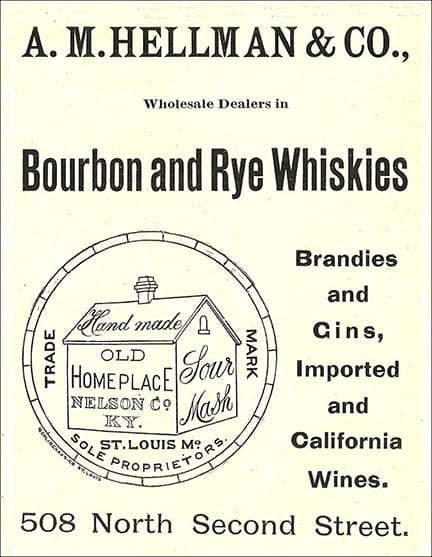
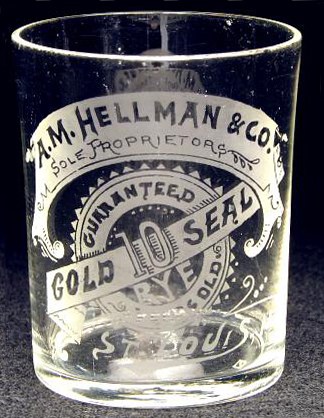
Charles Hellman ran things next and was the son of Isaac Hellman. He was educated in military academies in the United States and Germany. He went into mercantile business first and became the head of Hellmann Distilling Company in 1905. Eventually, it became one of the largest distilling houses west of the Mississippi River. When prohibition came, he moved into the insurance business with his son Isaac H. Hellman as Hellman & Hellman who had offices in the Pierce Building in St. Louis. He died in 1932.
Hellman’s Congress Bitters
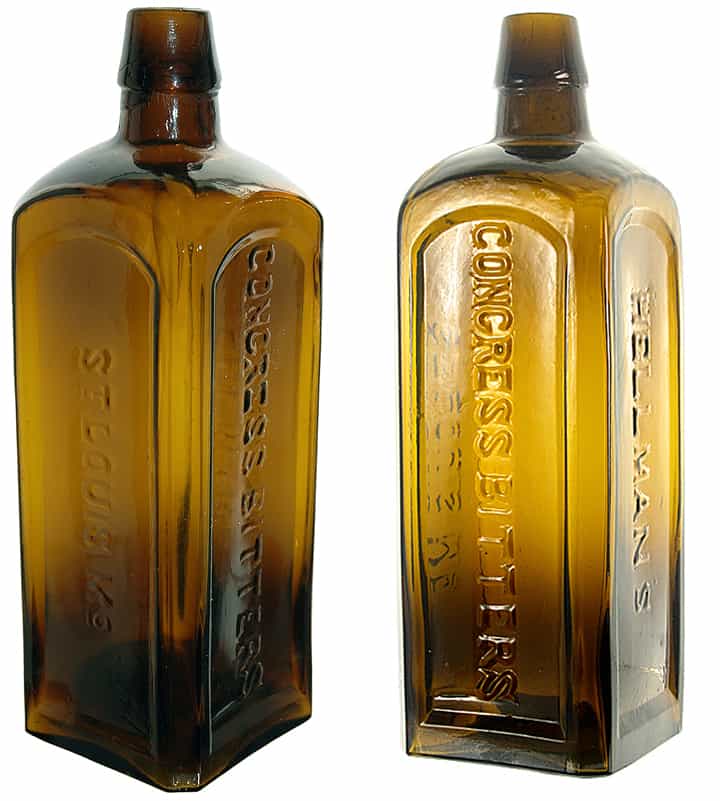
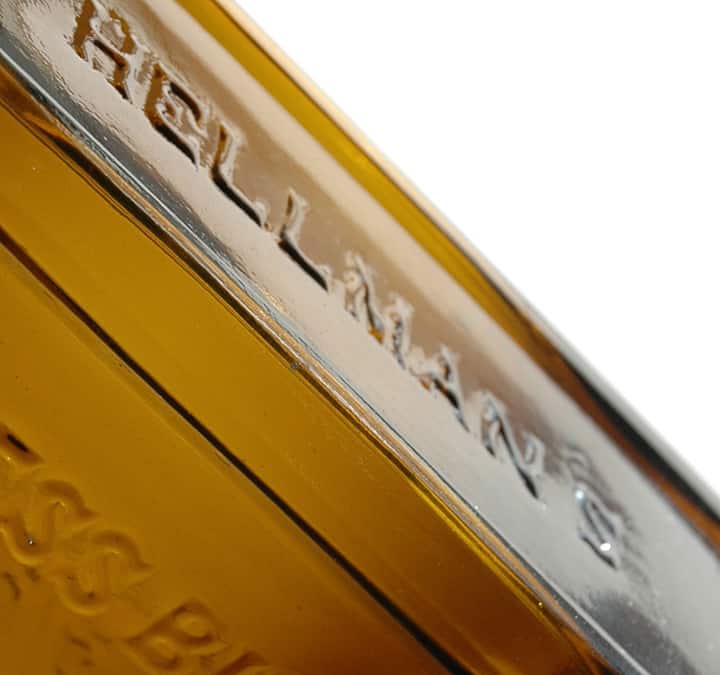
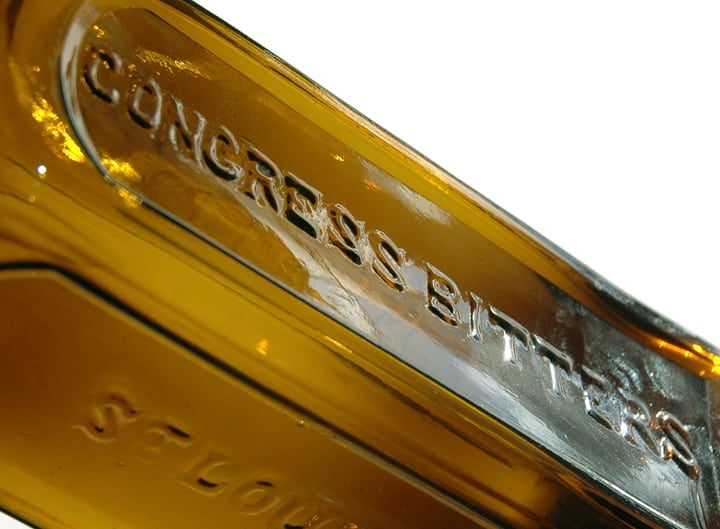
The pictures above are from my collection.
One of the greater mysteries to me is a listing in Bitters Bottles by Carlyn Ring and W.C. Ham under P 100 PINEAPPLE, L….The best tonic Brown’s Iron Bitters. There is the side note, “Also known is a paneled bottle embossed I. & L. M. Helman.” What did Carlyn and Bill mean? I have sent an email to Bill.
Read: Pineapple Bitters – The Different Variants
Advertising:
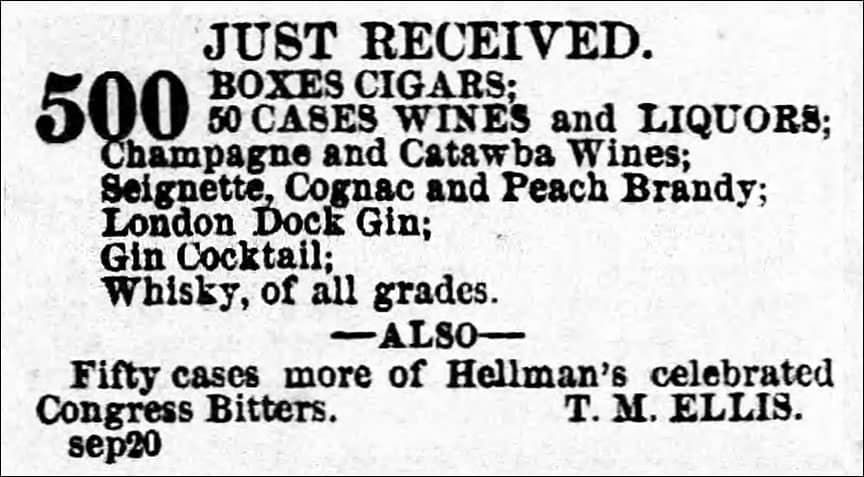
Fifty cases more of Hellman’;s celebrated Congress Bitters advertisement – The Vicksburg Herald, Saturday, October 28, 1865
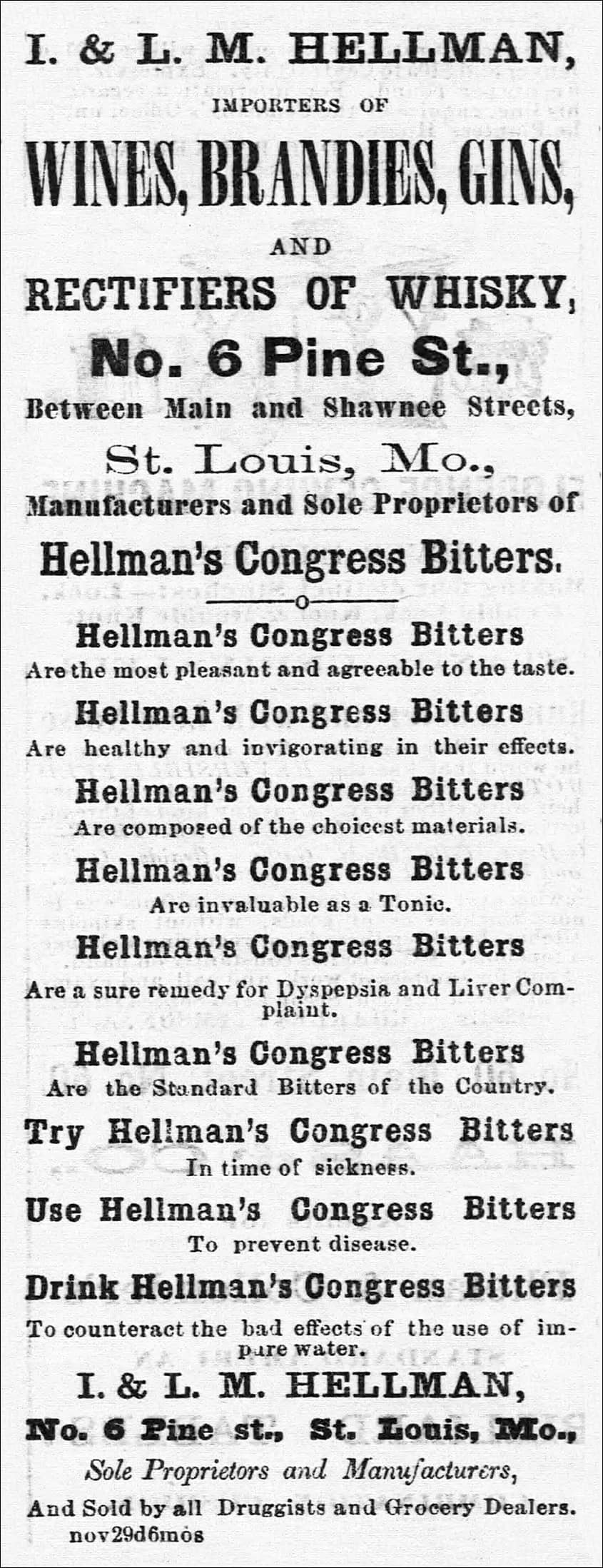
I. & L. M. Hellman advertisement for Hellman’s Congress Bitters, No. 6 Pine Street, St. Louis, Missouri – The Leavenworth Times, Wednesday November 29, 1865
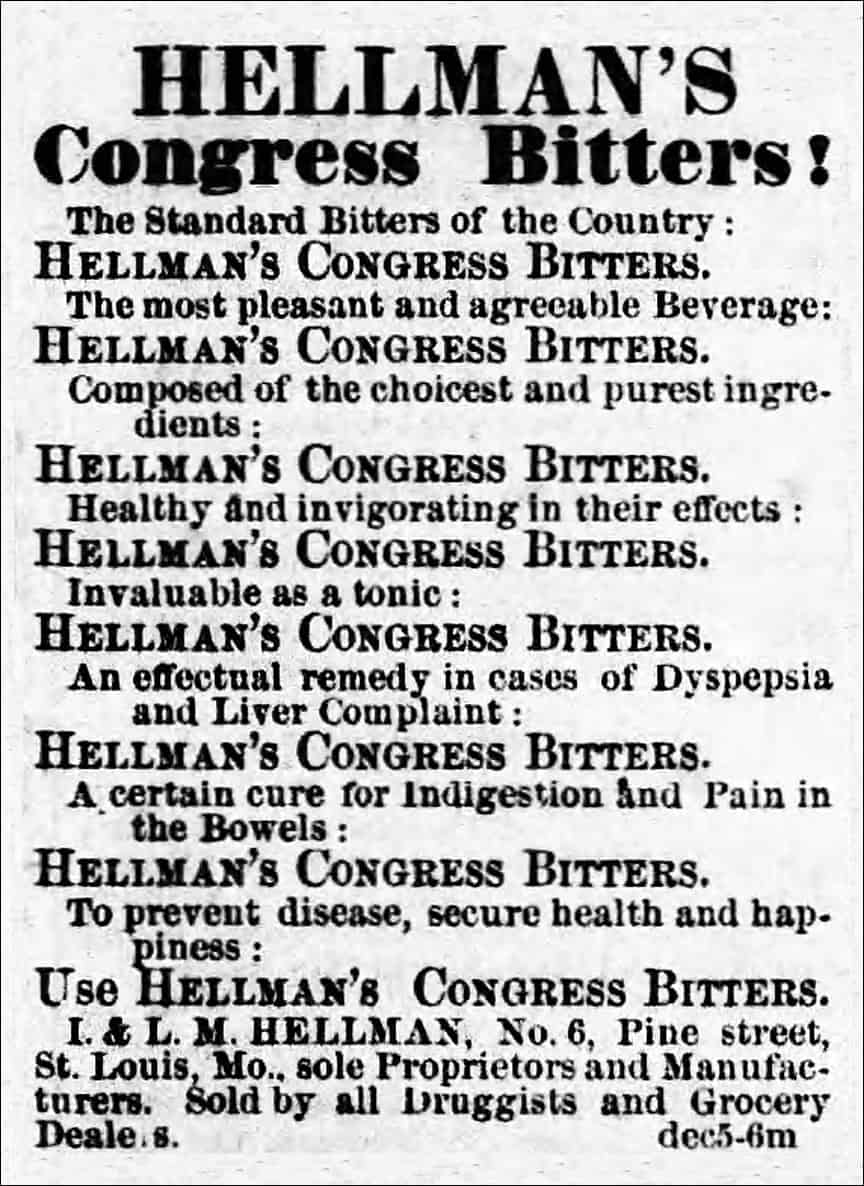
Hellman’s Congress Bitters! advertisement for I. & L. M. Hellman, No. 6 Pine Street, St. Louis, Missouri – The Vicksburg Herald, Saturday, January 6, 1866
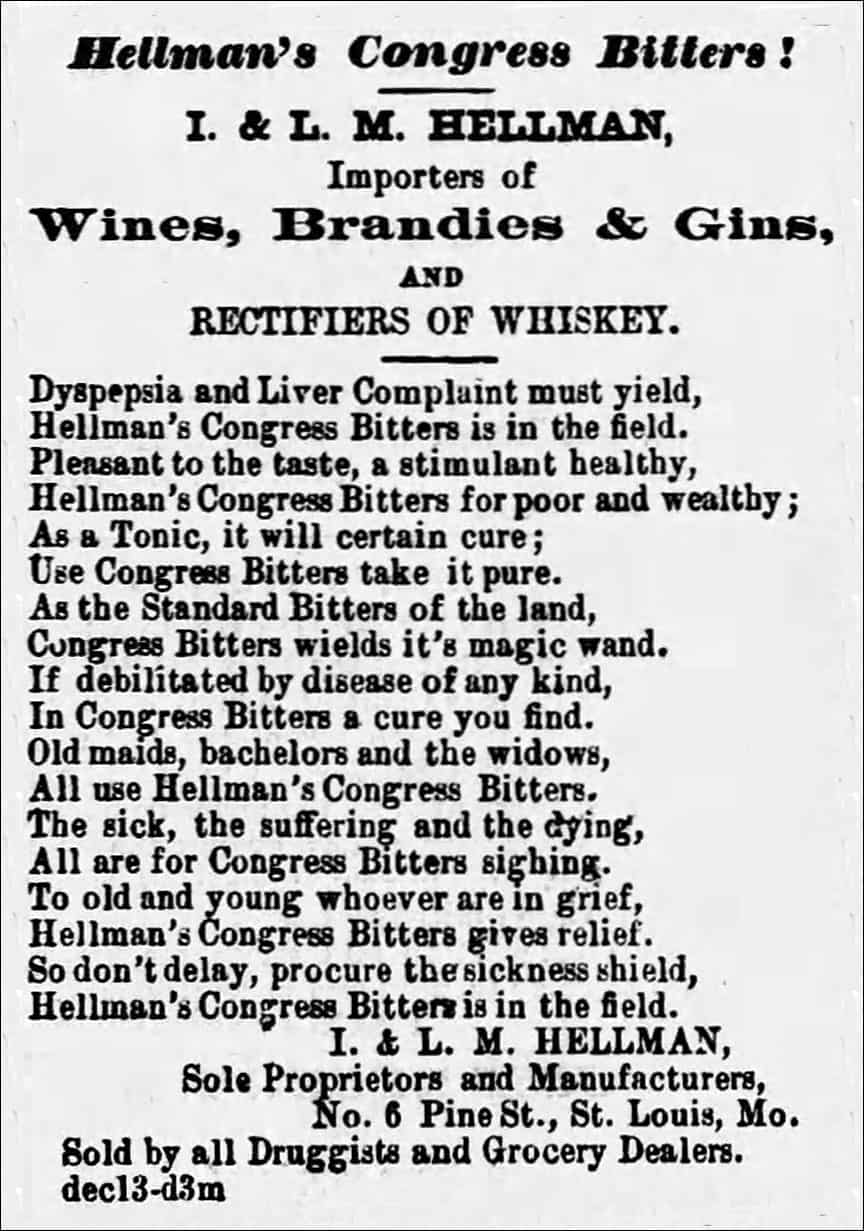
Hellman’s Congress Bitters! advertisement for I. & L. M. Hellman, No. 6 Pine Street, St. Louis, Missouri – Natchez Daily Courier, Saturday, March 3, 1866
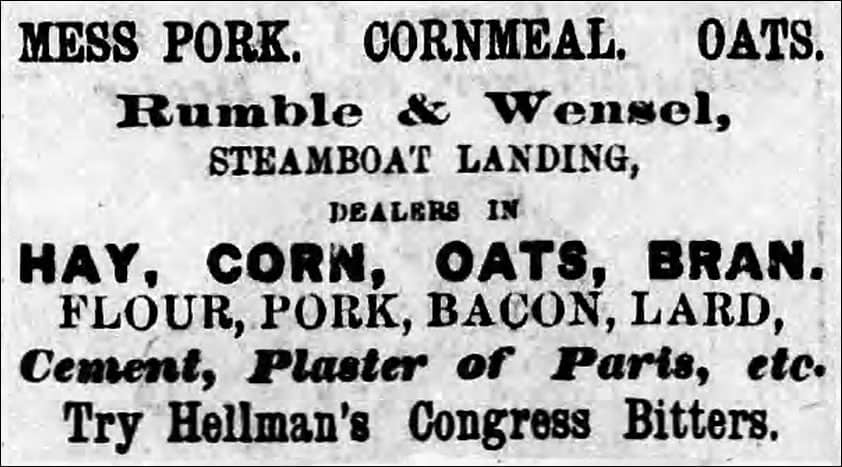
Rumbel & Wensel “Try Hellman’s Congress Bitters” – The Natchez Bulletin, Wednesday, February 16, 1870
Legal:
The Federal Reporter: With Key-number Annotations, Volume 155, Robert Desty, James Wells Goodwin, Peyton Boyle, West Publishing Co., 1907
W. A. GAINES & CO. v. KAHN et al.
(Circuit Court, E. D. Missouri, E. D. June 13, 1907.)
No. 5,096.
1. TRADE-MARKS And TRADE-NAMES—RIGHT TO TRADE-MARK —”OLD CROW” WHISKY
The words “Old Crow” were first used to designate a whisky made according to a secret formula by one James Crow, who was employed as distiller at a distillery in Kentucky, commencing in 1835. After his death In 1855, the manufacture was continued for a time at the same distillery by one who had learned the formula from him. During the latter part of such time, the distillery was leased by complainant’s predecessors in business, who employed such person as distiller, and continued to use the names “Crow” and “Old Crow” to designate their product. Later they built a distillery of their own near by, and since that time they and complainant have continued to use the same process and the same name, which has become well known In the trade as designating complainant’s goods exclusively. Shortly after complainant’s predecessors built their distillery, the original distillery where the Crow whisky was first made was torn down and another built in its place, which has never used the Crow formula nor the name. Held, that complainant was entitled to protection in the exclusive use of the name -“Old Crow” as designating its goods.
[Ed. Note.—For cases in point, see Cent. Dig. vol. 46, Trade-Marks and Trade-Names, §§ 29-41.]
2. SAME–FRAUDULENT USE OF NAME
The fact that defendants prior to the leasing by complainant’s predecessors of the distillery where the “Old Crow” whisky was originally made put upon the market a blended whisky of their own make under the name of “P. Crow” and “J. W. Crow,” for the purpose of deceiving purchasers as to its quality and origin, gave them no right to claim such names as a trade-mark, as against complainant.
[Ed. Note.—For cases in point, see Cent. Dig. vol. 46, Trade-Marks and Trade-Names, § 76.]
In Equity. Suit for infringement of trade-mark.
James L. Hopkins and Daniel W. Lindsey, for complainant.
Klein & Hough, for respondents.
DYER, District Judge. The bill in this case is, in substance, as follows: The plaintiff is a Kentucky corporation, engaged in the manufacture and sale of whisky in Woodford county, Ky.; that at the time this suit was commenced Moritz Hellman and Abraham M. Hellman were copartners in the liquor business in the city of St. Louis under the firm name of A. M. Hellman & Co.; that since the original bill in this case was filed Abraham Hellman has died, and the respondent Max Kahn has been duly appointed administrator of his estate.
The complainant claims that it is the sole and exclusive owner of a certain trade-mark for whisky, consisting of the words “Old Crow,” and that this mark has been used by it and its predecessors in business for about 40 years, and that this mark has been applied by it and its predecessors to packages by marking, branding, stamping, and labeling. It is further averred in the bill that the plaintiff corporation is the successor in business of W. A. Gaines & Co., copartnership, and that W. A. Gaines & Co. was the successor of Gaines, Berry & Co., a copartnership. It is further charged that in the year 1867 Gaines, Berry & Co. adopted and commercially applied the words “Old Crow” as a trade-mark for whisky distilled by them; that the name was so used by them until 1870, when they were succeeded in business by W. A. Gaines & Co., to whom the same with all other assets were transferred; that the firm of W. A. Gaines & Co. (the copartnership) continued the use in the same way of the mark until 1887, when they were succeeded by the complainant corporation; that after this succession the complainant continued to use and is now using the mark in the same way as its predecessor. It is further averred in the bill that in the year 1835 one James Crow became domiciled upon Glenn’s Creek, in Woodford county, Ky., and there began the manufacture of a whisky of superior excellence and quality, which became designated about that time as “Crow” or “Old Crow”; that James Crow was continually from 1835 to the time of his death in 1855 engaged in the distillation of said whisky which was known and designated as “Crow” or “Old Crow” whisky, and that during his lifetime this whisky acquired a wide and extensive sale and reputation; that upon the death of the said James Crow there was upon the market a considerable quantity of that kind of whisky, and that it was known commercially and sold and dealt in continuously by various persons until the year 1867, when die copartnership of Gaines, Berry & Co. began the production of whisky, using the same process and material that had theretofore been used by James Crow, and conducting the distillation of whisky upon Glenn’s Creek, in Woodford county, Ky.; that from the time of the death of Crow until 1857 there was no whisky produced upon the said Glenn’s Creek or elsewhere to which the said words “Crow” or “Old Crow” were applied as a trade-mark.
It is further stated in the bill that the words “Crow” or “Old Crow” had been left open for adoption, by the death of the said James Crow and the cessation of the distillation of the whisky designated by the said words, so that the same were lawfully appropriated and used by Gaines, Berry & Co. in the year 1867. It is further “averred in the bill that from the time when the process of making of said whisky was first devised and put into use by Crow in 1835 down to the present time the words “Old Crow” have been applied continuously to the whisky produced by the said process, and to no other whisky whatsoever, and that the distillation and production of said whisky made by said process has always been made at Glenn’s Creek, Woodford county, Ky., and in no other place in the United States, or anywhere else in the world; that the words “Old Crow” have continuously since the year 1835 down to the present time indicated to the public and particularly to all consumers of and dealers in whisky throughout the world that the whisky to which they were applied was made by the said process devised and invented by the said James Crow, and to no other whisky whatsoever; that the words “Old Crow” have continually since the year 1835 down to the present time indicated to the public and particularly to consumers of and dealers in whisky throughout the world that the whisky to which these words were applied is and was distilled at Glenn’s Creek, Woodford county, Ky. It is further averred that the said whisky to which the words “Old Crow” are applied is sold at a higher price than any other whisky of equal age produced in the United States, and this by reason of its uniform excellence and the skill and care devoted by complainants to the selection of the materials used, and to the process of distillation, together with the natural advantages of the locality in which the complainant’s distillery is situated. It is further averred in the bill that the complainant and its predecessors have expended large sums of money in and about the advertising of said whisky throughout the United States. It is further averred that the said mark “Old Crow” is a lawful and valid subsisting trade-mark, and that complainant has been universally recognized as the sole and exclusive owner thereof; that complainants have, by reason of the uniform excellence of the whisky distilled and sold by them under the trade-mark “Old Crow,” established a large and continuously increasing trade and demand for said whisky, so distinguished by said trade-mark. It is then charged that the rights of the complainant being well known, the defendants have unlawfully disregarded the same, and have from the 1st of January, 1903, and thence continuously and from day to day until the filing of the bill of complaint herein made or caused to be made, sold or caused to be sold in the city of St. Louis, and state of Missouri, and elsewhere, a compounded liquor or liquid to which they applied the trade-mark “Old Crow,” and that this was done against the consent of the complainants and in violation of their trade-mark rights. It is further averred that, by the fraudulent acts of the defendants, they have sold a spurious compounded liquor as and for complainant’s whisky, and have diverted to themselves trade to which the complainant was entitled, and which it would have otherwise received; that the whisky so sold by the respondents was purchased by the public and the consumers thereof in the false belief that it was complainant’s whisky; and that, by reason of the inferior quality of the liquor so sold by respondents, the reputation of complainant’s whisky has been greatly damaged. It is further claimed that the said unlawful and wrongful acts of the respondents constitute unfair competition in trade; that the said acts are now continued and are imperiling and jeopardizing the complainant’s established trade and good will.
The answer of the defendants makes specific denials of each and every allegation in the complainant’s bill contained, except that they admit that at the time of the filing the bill of complaint Moritz Hellman and the late Abraham M. Hellman were copartners doing business under the name and style of A. M. Hellman & Co., and that said Abraham M. Hellman is dead and Max Kahn has been appointed his administrator.
The respondents in their answer affirmatively set up and state that in 1863 the firm of I. & L. M. Hellman, a copartnership composed of Isaac and Louis M. Hellman, were the predecessors in business of Moritz Hellman, and the late Abraham M. Hellman; that they did a general wholesale liquor business in the city of St. Louis, Mo., and made and produced according to their own formula a blended whisky, which said firm of I. & L. M. Hellman & Co. designated as “Crow” or “Old Crow” whisky, and branded and stamped upon barrels, kegs, boxes, and bottles containing the said whisky the figure of a crow and the words “Crow,” “Old Crow,” and “Celebrated Old Crow,” and “J. W. . Crow’s Bourbon,” together with the firm name and the word “Hellman’s,” and continuously sold and dealt in whisky in packages so stamped, branded, and labeled, and continuously designated the said whisky to the trade by the said names and each of them, until the year 1867, when Isaac Hellman, one of the members of the firm of I. & L. M. Hellman, departed this life; that, after the death of Isaac Hellman, Louis M. Hellman acquired all the rights and property of said Isaac Hellman in the firm of I. & L. M. Hellman, including the right to make and produce whisky according to the formula of said firm and sell the same, and to use and apply to such whisky the said names of “Crow,” “Old Crow,” and “Celebrated Old Crow,” and “J. W. Crow’s Bourbon,” together with the brands, labels, marks, and figures used in connection therewith.
It is claimed by the respondents that they and their predecessors are rightfully entitled to the use of the said words “Crow,” “Old Crow,” “Celebrated Old Crow,” and “J. W. Crow’s Bourbon,” and the figure of a crow, as a trade-mark for and upon the whisky made and produced by them, and that this was well known to the complainant herein ever since the year 1896, and acquiesced in by the complainant since that time. The respondents then aver that the whisky produced by the complainant and sold by it under the firm name of “Crow,” “Old Crow,” and represented by them to be whisky of superior excellence, is in point of fact a whisky containing a large and dangerous percentage of fusel oil, a deadly poison, and a large percentage of other dangerous and deleterious impurities, and that the same is unwholesome and impure, and that the same has not been subjected to any process of rectification, blending, or vatting for the purpose of removing such dangerous and deleterious impurities, and that in representing said whisky to be pure and of superior excellence the complainant is guilty of fraud upon the public, and especially upon purchasers and consumers of whisky.
The replication to this answer on the part of the complainant is a general denial.
Respondents to the bill in this cause have filed a cross-bill, in which they themselves are complainants and the W. A. Gaines & Co. (corporation) is made respondent. In this cross-bill the averments are along the lines marked out in their answer to the original bill in this cause. In this cross-bill complainants ask for affirmative relief against the corporation, W. A. Gaines & Co. There is an answer filed to this cross-bill by W. A. Gaines & Co., and a replication to the answer by Hellman and Kahn. The bill and cross-bill practically present the same question.
The questions for my consideration have been in a great measure passed upon by courts of competent jurisdiction in the states of Missouri and New York.
In the Missouri case the facts relied on by the complainant are substantially the same as those appearing in the record now before the court. The recital of the facts by Judge Smith of the Kansas City Court of Appeals I find to be substantially the facts disclosed in the testimony of the witnesses for the complainant here. Judge Smith, in his recital of the facts in the case before him, says:
“It is disclosed by the evidence that one James Crow, a distiller, had a secret formula for the making of whisky. He was employed in 1833 by Oscar Pepper, the owner and operator of a distillery, for whom he made whisky according to his formula until 1855. He died a year later. The whisky made by him was of excellent quality. One Mitchell, who had worked with Crow and had learned his formula, took Crow’s place, and continued to make whisky at the Pepper distillery until the latter’s death in 1S65. After the death of Pepper one Edwards leased the distillery, and carried it on for about a year. In February, 1867, Gaines, Berry & Co. leased it and carried it on until July, 1809. In the last-named year this copartnership built and moved into a new distillery, located about three miles away from the Oscar Pepper distillery. Prom 1800 to 1871 the latter was not operated. In 1S70 the copartnership was succeeded by that of W. A. Gaines & Co., which later in 18S7 was succeeded by the plaintiff. When Gaines, Berry & Co. leased the Pepper distillery, they employed Mitchell, already referred to as Crow’s pupil, as their distiller, and be remained in their employment and that of their immediate successor, W. A. Gaines & Co., until 1872, and during all that time the whisky output of the distillery of these firms was made according to the Crow formula. One Van Johnson, who worked with Mitchell for several years, succeeded Mitchell as distiller in the employment of W. A. Gaines & Co., and used the Crow formula in the production of whisky by the latter and its successor, the plaintiff, so that the Crow formula has been continuously used in the production of whisky by the several parties named for nearly three-quarters of a century. It is true that, after the expiration of the second lease of the Pepper distillery in 1873, James E. Pepper (son of Oscar Pepper) and E. H. Taylor operated it for a year or so, and then tore it down, erecting a new distillery in its place. This last-named copartnership was succeeded in the ownership of the new distillery by Labrot & Graham, ‘who have operated it ever since its acquisition by thein.’ It does not appear that after Gaines, Berry & Co. left the old Osear Pepper distillery any one operating it or the new one erected in its place ever used the Crow process in the making of whisky, or that they or any of them ever applied the words ‘Old Crow’ to any whisky of their production. It does not appear that Oscar Pepper ever used the words ‘Old Crow’ to designate the whisky produced at his distillery after James Crow left his employment . From 1855 to 1865, he operated his distillery, and designated its production as ‘Old Oscar Pepper’ whisky. Edwards, who next operated the Oscar Pepper distillery, as previously stated, designated the whisky produced by him ‘Edwards’ Whisky,’ and did not apply the words ‘Old Crow’ to it. From 1855 to 1867, when Gaines, Berry & Co. took charge of the old Oscar Pepper distillery, no ona used the words ‘Old Crow’ or ‘Crow’ to designate his whisky. They began in the last-named year f1867] to apply the words ‘Old Crow* to whisky of their production, and they and their successors down to the present time have continued to do so. It does not clearly appear that Oscar Pepper used the words ‘Old Crow’ or ‘Crow’ to designate the whisky produced by him while Crow was in his employment; but, if he did, it is certain that he discontinued their use after Crow left his service.” Smith, P. J., In W. A. Gaines & Co. v. Whyte Grocery. Fruit & Wine Co., 107 Mo. App. 507, 81 S. W. 048-ttaii.
It was intimated by counsel for the defendants in this case upon the oral argument that the case above referred to should have but little weight in determining the case before this court, for the reason that that case was not properly tried for the defendants, and that it savored somewhat of collusion. I have examined the record in that case, and I am satisfied that the suspicion indulged in by counsel is not well founded.
The evidence in this case shows beyond question, as I think, that James Crow began distilling a certain kind of whisky, on Glenn’s Creek, in Woodford county, Ky., in the year 1835. This whisky was made according to a formula known only at that time to Crow himself. Crow gave the name of “Crow” or “Old Crow” to the whisky made by him from 1835 to 1855, in which latter year he died. During all of that time he was the distiller for Oscar Pepper at the distillery of the latter on Glenn’s Creek, in Woodford county, Ky. After the death of Crow, one Mitchell, who had worked in the same distillery with him, and who, during the time, became acquainted with Crow’s formula, continued to make the same kind of whisky. The whisky was known to the trade by the name of “Crow” or “Old Crow,” and was of superior quality, and was easily sold at a good price.
The evidence in this case satisfies me that in the year 1863 the defendants or their immediate predecessors were engaged in the whisky business in the city of St. Louis, and that during that year they offered a whisky of their own make for sale and called it “Crow” whisky. I am satisfied that this was done by them for the purpose of deceiving their customers as to the character of the whisky offered by them. They marked the barrels “Crow,” and also used a picture of the bird on some of the packages. It was an attempt to palm off on the trade an inferior whisky, made under the name of “Crow”; they well knowing at the time the superior quality of the whisky manufactured on Glenn’s Creek, in Woodford county, Ky. It was unfair competition, in that they sought to make others believe that they were selling the genuine “Old Crow” whisky, when, in fact, they were offering an inferior production of their own.
The claim that is made by the defendants in their answer, as well as in their cross-bill, that they adopted the trade-mark of “Old Crow” long before 1867, cannot be allowed.
A case involving the same question as that here presented was before the Supreme Court of New York in Gaines v. Leslie, 54 N. Y. Supp. 421, 25 Misc. Rep. 20. In that case the court said:
“It appears that these words have been used for many years by the plaintiff, and its predecessors In business, as the mark of their brand of whisky, purporting to be the brand originally taking its name from one James Crow, a distiller, employed some 60 years ago In a distillery located near to or upon the site of the plaintiff’s present ‘Old Crow’ distillery in the state of Kentucky. Certain evidence received without objection upon the trial would tend to show that the plaintiff has succeeded directly to the rights of the original distillers of this ‘Crow’ whisky, and, In any event, 1 think that the prima facie case, as to title, is supported by the reasonable inference to be drawn from the evidence, that, If the original distillers had a right to a trade-mark Iu the word ‘Crow,’ the right was abandoned to this plaintiff, or to its predecessors, and that their privilege to use the word became fixed, through general acceptance, In the course of succeeding years.” Bischoff, J., In W. A. Gaines & Co. v. Leslie, 54 N. Y. Supp. 421-423, 25 Misc. Rep. 20.
The evidence in the record in this case abundantly supports the opinions in the Missouri and New York cases above referred to.
The defendants have shown by some evidence in the case that they used the words “P. Crow” and “J. W. Crow” on packages put up by them. Why were they so used? No one by the name of “P. Crow” or “J. W. Crow” was ever in the employ of the defendants, and no satisfactory reason is given for the employment of the name or names. The evidence, on the other hand, is overwhelming, and is practically uncontradicted, that James Crow began distilling whisky in Kentucky as far back as 1835, and so continued until his death in 1855, that during all of that time he used on the packages containing whisky made by him the words “Crow” or “Old Crow,” and that from 1867 until the present time the complainant and its predecessors have used the words “Old Crow” in designating the whisky made by them. •
I do not deem it necessary to pursue this matter further. The motion heretofore filed by the defendants to expunge certain exhibits filed by complainant will be overruled.
The cross-bill filed by the defendants will be dismissed, and a decree entered in favor of the complainant according to the prayer of the bill.
Select Listings:
1833: Isaac M. Hellman, Birth: 8 October 1833, Birth Place: Bavaria (Bayern), Germany – U.S., Find A Grave Index, 1600s-Current
1865: I. & L. M. Hellman (Isaac Hellman and Louis M. Hellman), commission merchants and dealers in wines and liquors, 6 Pine – St Louis, Missouri, City Directory, 1865
I. & L. M. Hellman, (Successors to Hellman & Myers) Commission Merchants, Importers of Wines, Branndies & Gins, Manufacturers Of Domestic Liquors & Champagne Cider. Rectifiers of Whisky. 6 Pine Street, Between Main and Second, St. Louis, Mo.
1865: Listing (below) for Isaac Hellman and his Tonic Bitters April 11, 1865 – House Documents by United States Congress. – 1865 & 1866

1865: Newspaper advertisement (above) I. & L. M. Hellman advertisement for Hellman’s Congress Bitters, No. 6 Pine Street, St. Louis Missouri – The Leavenworth Times, Wednesday November 29, 1865
1866-67: I. & L. M. Hellman (Isaac Hellman and Louis M. Hellman), liquors, wholesale, 6 Pine – St Louis, Missouri, City Directory, 1866
1867: Isaac M. Hellman, Death: 3 August 1867, Cemetery: New Mount Sinai Cemetery & Mausoleum, Affton, St. Louis County, Missouri, Spouse: Bertha Hellman, Children: Pauline Sayers, Hattie Heller, Charles Hellman, Mathilde Hellman – U.S., Find A Grave Index, 1600s-Current
1868: Hellman I. & L.M. (Louis M. Hellman), importers of wines, brandies and gins, and rectifiers for whisky. 112 Pine Street – St. Louis City Directory
1881: I. & L.M. Hellman (Louis M. and Abraham M. Hellman, and Myer Harris), Moritz Hellman, traveling salesman, importers wines, brandies, etc., 112 Pine – St Louis, Missouri, City Directory, 1866
1887: A.M. Hellman & Co. (Abraham M. Hellman and Myer Harris), liquors, Wholesale, 112 Pine – St Louis, Missouri, City Directory, 1887
1891: Advertisement (above) A.M. Hellman & Co., Wholesale Dealers in Bourbon and Rye Whiskies, 508 North Second Street
1932: Newspaper Obituary (below) Charles Hellman, Insurance Man and Ex-Distiller, Dies – St Louis Post Dispatch, Monday, September 19, 1932
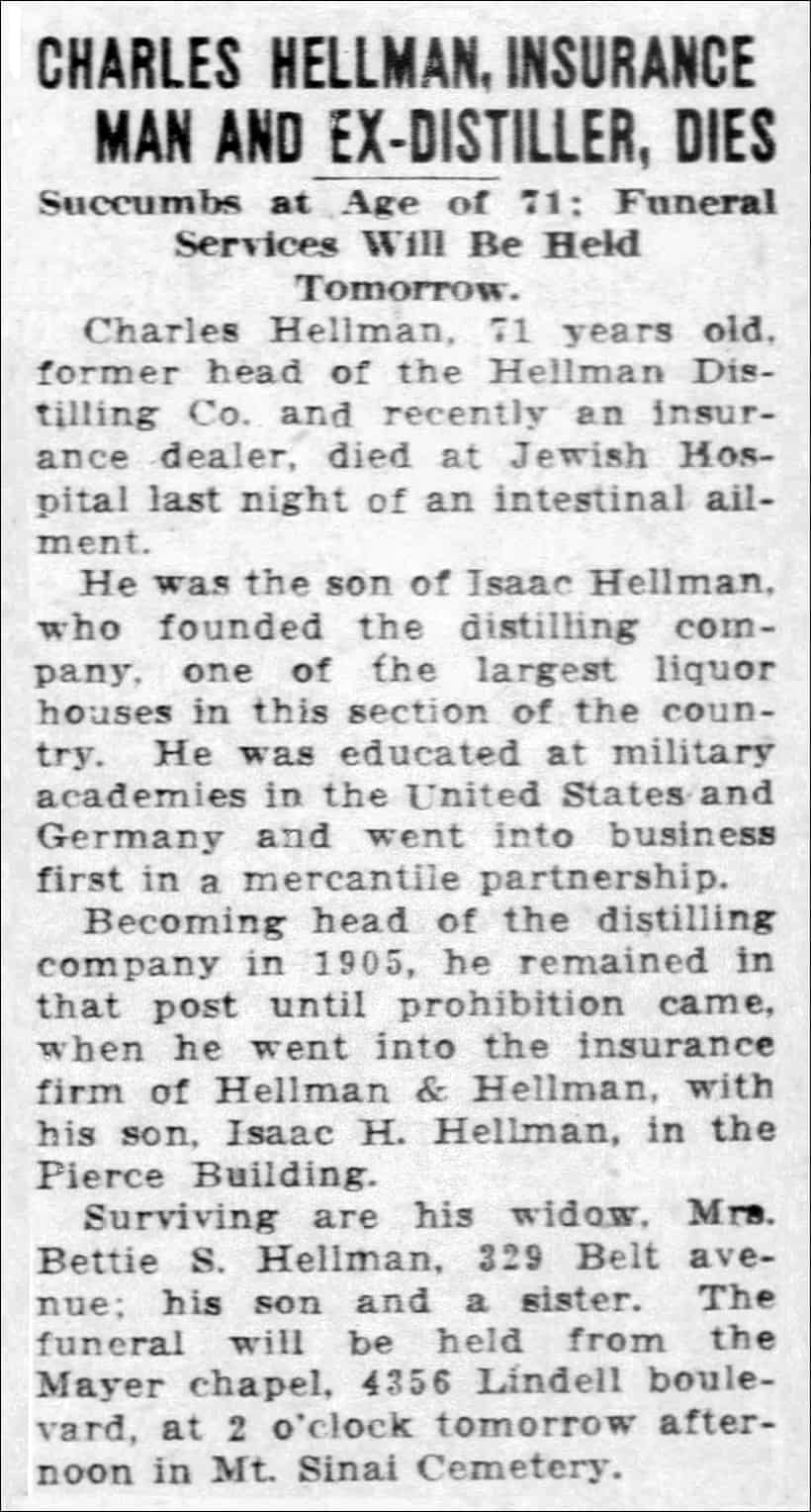
![]() I received the following email and pictures from Matthew Levanti about a bottle embossed I & L. M. Hellman, St. Louis, Mo. This really looks like a bitters bottle that I bet I can shed some light on. The image at the top of the post is from a past Glass Works Auction.
I received the following email and pictures from Matthew Levanti about a bottle embossed I & L. M. Hellman, St. Louis, Mo. This really looks like a bitters bottle that I bet I can shed some light on. The image at the top of the post is from a past Glass Works Auction. Examples found during the excavation of the riverboat Twilight which sank near Orrick, Missouri in 1865.
Examples found during the excavation of the riverboat Twilight which sank near Orrick, Missouri in 1865. Hellman is a name associated with liquor dealing St. Louis for many decades. We first see listings for Hellman & Myers. The name changes to I. & L. M. Hellman from 1863 to 1881. This would be Isaac Hellman and Louis M. Hellman. From 1882 to 1900, it is A. M. Hellman & Co. (Moritz and Abraham Moses) and finally the Hellman Distilling Company (Charles Hellman) up to 1918. They were orginially located at 6 Pine Street from 1863-1866, then at 112 Pine from 1867-1887, and finally they were located at 508 N 2nd. The company used the brand names Arlington Club Bourbon, Arlington Club Rye, Arnold’s Bourbon, Arnold’s Rye, Elk Spring Bourbon, Elk Spring Rye, Gold Seal Rye, Hellman’s Congress Bitters, Hellman’s Cedar Grove Bourbon, Home Place B’b’n, Home Place Rye, O. V. F. Bourbon, Porter Bourbon, and Silver Spring Rye.
Hellman is a name associated with liquor dealing St. Louis for many decades. We first see listings for Hellman & Myers. The name changes to I. & L. M. Hellman from 1863 to 1881. This would be Isaac Hellman and Louis M. Hellman. From 1882 to 1900, it is A. M. Hellman & Co. (Moritz and Abraham Moses) and finally the Hellman Distilling Company (Charles Hellman) up to 1918. They were orginially located at 6 Pine Street from 1863-1866, then at 112 Pine from 1867-1887, and finally they were located at 508 N 2nd. The company used the brand names Arlington Club Bourbon, Arlington Club Rye, Arnold’s Bourbon, Arnold’s Rye, Elk Spring Bourbon, Elk Spring Rye, Gold Seal Rye, Hellman’s Congress Bitters, Hellman’s Cedar Grove Bourbon, Home Place B’b’n, Home Place Rye, O. V. F. Bourbon, Porter Bourbon, and Silver Spring Rye.






















